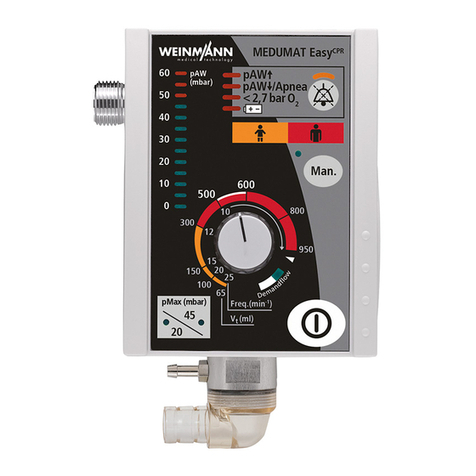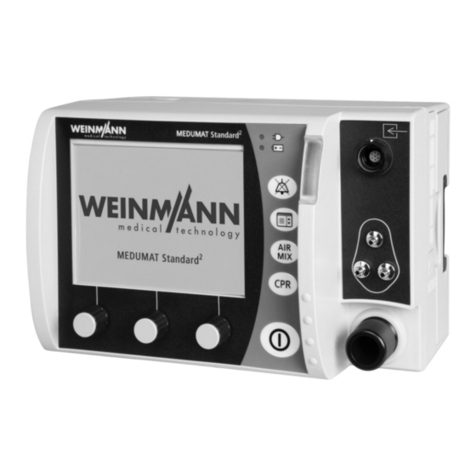
Contents 3
English
Contents
1. Overview . . . . . . . . . . . . . . . . . . . 4
1.1 Device . . . . . . . . . . . . . . . . . . . . . 4
1.2 Special symbols on the ventilator . 6
2. Legend . . . . . . . . . . . . . . . . . . . . . . 9
3. Description . . . . . . . . . . . . . . . . . 10
3.1 Intended use. . . . . . . . . . . . . . . . 10
3.2 Owner/operator and user
qualification . . . . . . . . . . . . . . . . 11
3.3 Ventilation function . . . . . . . . . . 11
3.4 Demandflow function . . . . . . . . 12
3.5 Patient hose system with patient
valve. . . . . . . . . . . . . . . . . . . . . . 12
3.6 Audio response . . . . . . . . . . . . . 13
4. Safety instructions . . . . . . . . . . 14
4.1 Safety regulations . . . . . . . . . . . . 14
5. Installation . . . . . . . . . . . . . . . . . 18
5.1 Connecting the oxygen cylinder . 18
5.2 Ventilation hose . . . . . . . . . . . . . 19
5.3 Wall mounting set . . . . . . . . . . . 21
6. Using the ventilator . . . . . . . . . 22
6.1 Switching on / self test . . . . . . . . 22
6.2 Selecting the ventilation settings 23
6.3 Performing ventilation . . . . . . . . 25
6.4 Monitoring ventilation . . . . . . . . 25
6.5 Ventilation with PEEP valve . . . . 26
6.6 Ventilation with filter . . . . . . . . . 26
6.7 Demandflow . . . . . . . . . . . . . . . 27
6.8 Terminating ventilation or
Demandflow . . . . . . . . . . . . . . . 28
6.9 Alarm signals . . . . . . . . . . . . . . . 29
6.10 Audio response for user guidance 32
6.11 Calculation of oxygen content/
remaining operating time . . . . . 37
6.12 Alternative ventilation procedures 39
7. Hygienic preparation . . . . . . . . 40
7.1 MEDUMAT Easy . . . . . . . . . . . . . . 40
7.2 Patient valve . . . . . . . . . . . . . . . . 40
7.3 Ventilation hose . . . . . . . . . . . . . . 42
7.4 Masks . . . . . . . . . . . . . . . . . . . . . 42
7.5 Fittings. . . . . . . . . . . . . . . . . . . . . 42
7.6 Cleaning and disinfection
procedure . . . . . . . . . . . . . . . . . . 43
8. Functional checks . . . . . . . . . . . 45
8.1 Intervals . . . . . . . . . . . . . . . . . . . . 46
8.2 Checking for leaks in the system . 47
8.3 Check patient hose system . . . . . 48
8.4 Checking the minute volume . . . . 49
8.5 Checking maximum ventilation
pressure . . . . . . . . . . . . . . . . . . . . 50
8.6 Checking Demandflow . . . . . . . . 51
8.7 Checking the alarm systems . . . . . 52
9. Troubleshooting . . . . . . . . . . . . 54
10. Servicing . . . . . . . . . . . . . . . . . . . 56
10.1 Batteries . . . . . . . . . . . . . . . . . . . 57
10.2 Change valve membrane in
patient valve . . . . . . . . . . . . . . . . 58
10.3 Storage . . . . . . . . . . . . . . . . . . . . 58
10.4 Disposal . . . . . . . . . . . . . . . . . . . 59
11. Product and accessories . . . . . . 60
11.1 Standard product . . . . . . . . . . . . . 60
11.2 Accessories . . . . . . . . . . . . . . . . . 60
11.3 Spare parts . . . . . . . . . . . . . . . . . 62
12. Technical data . . . . . . . . . . . . . . 63
12.1 Pneumatic / electronic systems . . . 65
12.2 Relationship between ventilation
parameters. . . . . . . . . . . . . . . . . . 66
13. Warranty . . . . . . . . . . . . . . . . . . . 67
14. Declaration of conformity . . . . 67
15. Index . . . . . . . . . . . . . . . . . . . . . . 68
































